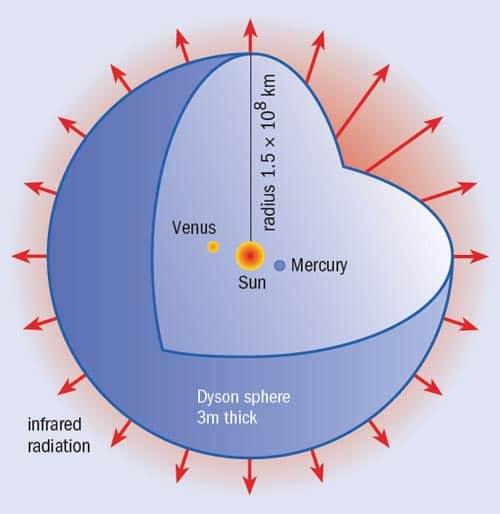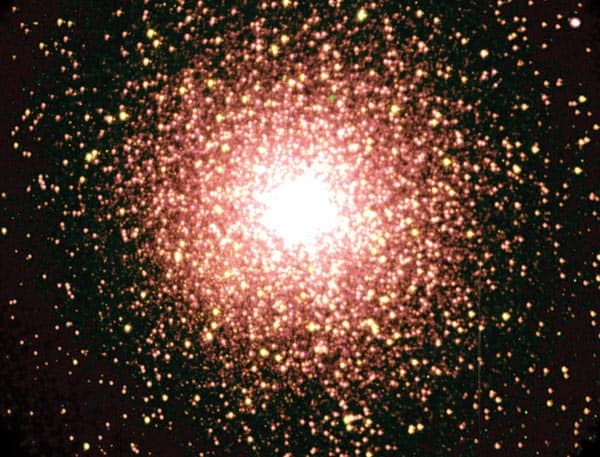Having so far failed to find evidence for extraterrestrial civilizations by searching for their radio transmissions, some physicists think it is worth scouring the sky for signs of their astronomical construction work, writes Bruce Dorminey

“If they are out there, where are they?” That is the conundrum famously expressed more than 50 years ago by the Italian-born physicist Enrico Fermi when referring to the possibility that intelligent extraterrestrial civilizations may lie beyond the confines of our solar system. Given the vast age of the universe and its enormous number of Sun-like stars, it seems logical that the Earth is not the only place where intelligent life has evolved. Yet for the past half century, researchers have been actively looking for signs of such extraterrestrial civilizations and thus far have come up empty-handed.
These searches have almost all involved looking for electromagnetic waves at radio or optical frequencies that might have been transmitted by alien civilizations. The first such interstellar surveys were undertaken by US astronomer Frank Drake at the National Radio Astronomy Observatory in 1960, and since then their efficiency has increased exponentially. Indeed, the recent inauguration of the purpose-built Allen Telescope Array in California will allow those involved in the search for extraterrestrial intelligence (SETI) to survey a million Sun-like stars for intelligent radio signals within a distance of almost 1000 light-years.
Having so far analysed a multitude of candidate extraterrestrial signals to no avail, a growing number of SETI researchers are advocating more radical methods to address Fermi’s question. One of the most innovative, which will be discussed this month at the Astrobiology Science Conference at Santa Clara in California, involves searching for evidence of extraterrestrial handiwork in the form of large-scale “astroengineering” projects.
Science-fiction writers have long postulated that advanced civilizations might be capable of harnessing all of their parent star’s energy by “macroengineering” their entire solar system, or even by harnessing the energy of an entire galaxy. While such feats of astroengineering remain the stuff of science fiction, there is nothing unscientific about asking what such structures would look like if others had built them and then searching the sky for evidence of their possible astronomical signature.
Dyson spheres
In 1960, inspired by science-fiction writer Olaf Stapledon’s 1937 novel Star Maker, the theoretical physicist Freeman Dyson posited that advanced civilizations might undertake massive astroengineering projects, which came to be known as Dyson spheres (Science 131 1667). Dyson described civilizations capable of harnessing their star’s energy by deconstructing a planet the size of Jupiter and creating from it a spherical shell 2–3 m thick that would rotate around the star. The sphere would have an average radius of 150 million kilometres (slightly larger than the distance between the Earth and the Sun). In principle, the inner surface of a Dyson sphere would capture and then transfer the solar radiation towards collection points where it could be converted into useable energy (see “Harnessing a Sun”).
This raises an intriguing prospect in the search for extraterrestrial life. In 1964 the Soviet physicist Nicolai Kardashev classified extraterrestrial civilizations in terms of how advanced they are — ranging from KI to KIII. The US astronomer Carl Sagan estimated that humankind is barely on the cusp of being a KI civilization, which is defined as one that can harness all the solar radiation striking its atmosphere. A KII civilization, in contrast, can use a Dyson sphere to directly harness its home star’s energy; while a KIII civilization can harness a whole galaxy’s energy.
“The sky is crowded with objects that are bright infrared sources but invisible in the optical band,” says Dyson. “There is no reason to suppose that any of them are artificial, but they look just the way a Dyson sphere is supposed to look.”
The problem is that it would be hard to pick out such artificial astronomical objects from the many other natural objects that look the same. While a perfect Dyson sphere would, in theory, absorb its star’s energy and therefore emit none of the optical or ultraviolet radiation that stars give off during most of their lives, the shell would reradiate waste heat and give rise to a strong infrared emission. At the beginning and end of their lives, however, stars are immersed in warm clouds of dust that also cause them to radiate strongly in the far infrared. Indeed, measuring a star’s infrared excess is currently the preferred method for finding putative protoplanetary disks around young stars (see “Observational challenge”).
The abundance of natural infrared sources would thus make it difficult to identify an artificial one using infrared radiation alone. Still, Dyson says that we could get lucky and detect an infrared source with a peculiar spectrum or a time variation that cannot be explained as a natural phenomenon. “We cannot say with certainty that such things are impossible,” says Dyson, who is an emeritus professor at the Institute for Advanced Study in Princeton.
Dan Werthimer, director of the SETI programme at the University of California at Berkeley, agrees. “You can argue until you’re blue in the face about whether civilizations build Dyson spheres, but if it’s a possibility then why not look?” he says.
Infrared inferences
There have already been a handful of searches for Dyson spheres. In 2004, Werthimer and his then undergraduate Charlie Conroy analysed spectral data from 1000 solar-type stars that were at least a billion years old, which ensured that the stars had long shed the dust associated with protoplanetary disks. The pair searched 32 stars with excess infrared emission for signs of anomalous radio emission or optical nanosecond laser pulses that would indicate an artificial-intelligent origin, but they found no verifiable signals. Werthimer says that the most likely explanation for these candidates was that there is some dust present even though they are old stars.
Meanwhile, retired Fermilab particle physicist Dick Carrigan, who still works from the high-energy physics lab just outside Chicago, has spent the last five years painstakingly whittling 11,224 sources identified by the Infrared Astronomical Satellite (IRAS) down to a handful of candidates with excess infrared emissions. Carrigan even accepted the possibility that some spheres might not be completely finished. From a survey region containing more than a million solar-type stars, two were scanned for anomalous radio signals: none were found.
One of Carrigan’s main selection criteria, in addition to a lack of dust and the absence of certain spectral lines that would indicate an artificial construct, was that sources must have infrared temperatures of 200–600 K. His reasoning was that life as we know it hovers around 200 K and that temperatures above 400 K could create problems for an alien civilization’s electronics. Unsurprisingly, not everyone agrees with this.
“It’s hard to predict that if civilizations build Dyson spheres, they will reradiate their waste heat at 200 K,” says Werthimer. “I also don’t buy the argument that they are going to have electronics identical to ours. You can’t rule out advanced civilizations just because you didn’t find excess heat with a wavelength of 12 μm [corresponding to a temperature of 250 K].”
Dyson spheres may not be easy to find, but looking for them is a bargain compared with real-time SETI searches, which usually involve an active observing programme with racks of sophisticated electronics and hi-tech telescopes. Furthermore, unlike most radio and optical SETI searches, astronomers looking for evidence of astroengineering need not assume that extraterrestrials have an active interest in interstellar communication. For all we know, they may be hi-tech hermits who simply want stellar longevity.
Astrophysicist James Annis at Fermilab has applied that philosophy to his own limited search for KIII civilizations. A few years ago he analysed the rotational dynamics of 137 different galaxies from the Ursa Major and the Virgo galaxy clusters. He plotted their stellar luminosity versus their stellar velocity dispersion, which is a measure of the dynamics and kinetics of stellar populations as the galaxies move in and through their host galaxies. An engineered galaxy, in which almost every Sun-like star within that galaxy had been enclosed within a Dyson sphere would have a very high infrared emission, low optical luminosity and a high galactic stellar rotational velocity in the case of spiral galaxies; or a high velocity stellar dispersion in the case of elliptical galaxies.
According to Annis’ calculations, one such macroengineering signature might be that you would see only about 100th of 1% of the light from the galaxy. “If you were to see obvious dust clouds around a candidate galaxy in the infrared, then it could be a dusty starburst galaxy where the dust is very clumpy and you can see ongoing star formation,” he says. “But if you got an infrared galactic image that was completely smooth with no lumpiness, that’s an interesting object.” To create such optical dimming on a galactic scale, a KIII galactic civilization would have needed to colonize almost every Sun-like star within its galaxy.
“We can already rule out certain kinds of civilizations,” says Werthimer. “I don’t think that there are civilizations out there that harness the whole power of their galaxies or cluster of galaxies. My guess is that just from the astronomical data on file we would have discovered such a civilization by accident.”
Stellar rejuvenation
Even if extraterrestrial civilizations do not decide to build Dyson spheres on galactic scales, they may be interested in rejuvenating their host stars. Our Sun is about halfway through its main-sequence phase, which will last for another five billion years or so. After it burns through about 10% of the hydrogen near its core, the Sun will start to go into its “red-giant” phase, when solar-mass stars leave the main sequence and expand outwards burning everything in their wake. Mixing any of the remaining hydrogen into the central region would therefore help stabilize the star and hinder the onset of this expansion. For example, if — one billion years from now — the inhabitants of the Earth were to somehow mix just 10% of the hydrogen in the Sun’s envelope deep into its core, then they would extend the star’s lifetime by another 10 billion years or so.
Planetary scientist Martin Beech at the University of Regina in Saskatchewan, Canada, says this might be possible using a laser. “If you could use a laser to create a hot spot near the Sun’s fusion core, then that would lead to natural convective mixing of extra hydrogen,” he says. That is hardly an option for the human race at this stage of our development, but is there any way we could find evidence that a more advanced KII civilization has achieved such a feat?
Fred Rasio, an astrophysicist at Northwestern University in Illinois, says that any process that would reinject fresh hydrogen fuel into a stellar core after the star has already burned for a while would make it look like a “blue straggler”. These stars are straggling along the main sequence at the hydrogen-burning turn off point, and are therefore hotter, brighter and bluer than all the other stars in the surrounding cluster. Blue stragglers are thought to be formed by collisions with other Sun-like stars or by a stellar binary merger, which redistributes hydrogen and causes them to evolve differently to stars with similar masses. About 5000 blue stragglers are known, and are usually found in young, open galaxy clusters like the one in which our Sun formed some 4.5 billion years ago and in older dense globular clusters of stars that encircle our galaxy.
Beech believes some fraction of blue stragglers could be astroengineered and would look essentially like a naturally evolved blue straggler, although many astrophysicists disagree. “These globular clusters are extremely inhospitable environments for life,” says Rasio. “The stars in them crash into each other on timescales that are shorter than their lifetimes.”
Mario Livio at the Space Telescope Science Institute in Maryland also points out that globular clusters are notoriously metal poor and are therefore not expected to be fertile hunting grounds for Earth-like planets. “Why invoke astroengineering within globular clusters to explain what is a very natural blue-straggler phenomenon?” he asks.
“At present this is a thought experiment,” says Beech, who is currently studying models that may allow natural and artificial blue stragglers to be distinguished. “Natural blue stragglers will presumably start to evolve to cooler temperatures, whereas a blue-straggler star that is being mixed artificially will always evolve to hotter temperatures. A blue straggler found to have temperatures hotter than those produced by natural mergers would become a likely candidate for an artificially engineered star,” he says.
Energy assumption
It is hard to second-guess what sort of engineering billion-year-old civilizations capable of colonizing every Sun-like star in the galaxy might have in mind. Werthimer realizes that if extraterrestrial life were ever found, it may be serendipitously through some experiment that has nothing to do with SETI — such as via neutrino, gravity-wave or monopole experiments. As Dyson points out, it is impossible to predict which form of stellar energy an alien civilization would choose.
“Some people think that advanced civilizations may have grown out of their technological phase into a more esoteric phase,” says Werthimer. “It’s not clear to me that just because right now our civilization is concerned about the price of oil, that’s what other civilizations are going to be into. You could have very advanced civilizations out there that aren’t thirsty for infinite amounts of energy.”






